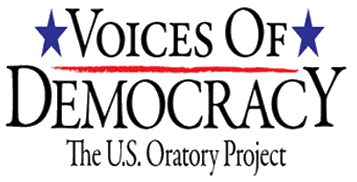DR. MARTIN LUTHER KING, JR. “HOW LONG? NOT LONG” (25 MARCH 1965)
Classroom Activities
- How did this speech make you feel? Discuss how your emotional reactions to the speech might differ from those of other students, and how you think your own reactions might have differed from those who witnessed the speech?
- In his speech, Dr. King repeatedly posed the question, “How long?” How many times did he ask that question, and what are the specific contexts in which he asked it? What reasons did he give to support the same answer each time: “Not long”? Do you sense that these repeated questions were asked in some order of importance? Why or why not?
- Dr. King used personification frequently in this speech. Choose three examples of personification and explain how you think they worked to relate his ideas to his audience. How would the speech have differed without these stylistic device?
- What do you think Dr. King meant in paragraph five when he said that the “conscious of America began to bleed”? Is this imagery meaningful to you? Why or why not?
- Dr. King used many Biblical references throughout his speech. Identify at least three examples of biblical references and explain how they may have added to Dr. King’s credibility as a speaker.
- Discuss what you think are the most significant stylistic features of King’s speech. How did he use qualifiers, such as mighty walk, desolate valleys, and trying hills? What effect did his use of personification have on the concepts being personified? How did Dr. King use repetition to emphasize phrases? Are there other recurrent stylistic features of the address that you think are significant?
Student Research
- Search online to find out how to create a word cloud. Create a word cloud using Dr. King’s speech text. What are the most prominent words in that word cloud? Discuss the implications.
- Find at least three sources that discuss the location from which Dr. King delivered this speech. Some sources report that he delivered it “from the steps” of the capital building in Montgomery, Alabama, while others state that Dr. King and his fellow marchers were not allowed on the capital grounds, including the steps. Why do you think there are these different accounts? What difference does it make? Reflect on the implications of how reporters “located” the speech.
- Did Dr. King participated in the entire march from Selma to Montgomery? If not, where do your sources say he went—and for what purpose?
- The City of St. Jude played an important role in the March from Selma to Montgomery. Research why this location is important to the history of the march. Where is the City of St. Jude in relation to the march? Who entertained the marchers at the City of St. Jude? How important was this stopover to the success of the march?
- Research the significance of the Dexter Avenue Baptist Church in the story of King and the civil rights movement. How far from that church was Dr. King when he delivered this speech? What was Dr. King’s connection to the church, and what was the church’s significance in the history of African Americans in Alabama? How is the historical significance of the church recognized today?
- What is the historical significance of the 54-mile walk from Selma to the state capital in Montgomery as a form of nonviolent social protest? Consider why King and his followers chose to march, instead of other types of protest.
- In 2-3 pages, explain the significance of the Civil Rights Act of 1964. What provisions were included in this act and which presidents were involved in getting the legislation passed?
- George Wallace is referenced in the speech in paragraph 8. Who was George Wallace and what was his historical significance to the Civil Rights Movement in the south?
- Paragraph 10 references the Populist Movement. In 2-3 pages, explain the historical significance of the Populist Movement in American politics.
- In his speech Dr. King stated that: “Our whole campaign in Alabama has been centered around the right to vote.” Explain the significance of a voting rights campaign, comparing it the Seneca Falls Convention of 1848 and the first wave of feminism, discussed in Stillion Southard’s essay in the Voices of Democracy.
Citizenship Resources
- What were the demands of the protestors in the Selma to Montgomery march? How many of these demands have since been met, by state or federal law, or by new policies that address these issues?
- In a speech in Selma, Alabama on March 7, 2015, President Barack Obama said “Our march is not yet finished. For everywhere in this country, there are first steps to be taken, there’s new ground to cover, there are more bridges to be crossed.” Discuss what you think President Obama meant when he said the march is not yet finished. What issues do you think he had in mind?
- Discuss some of the various mechanisms available to citizens in the U.S. for affecting social change. Other than marching for their rights, what avenues did civil rights activists pursue for addressing discrimination against African-Americans. What methods for effecting positive social change do you think are most effective today?
- What do you believe are the most pressing issues today for the Civil Rights movement? Have the issues changed since Dr. Kings time? Do you believe the situation has improved or worsened? Why? Provide contemporary examples to support your views.
